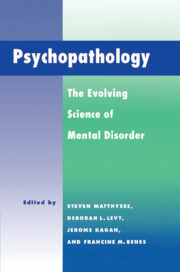Book contents
- Frontmatter
- Contents
- List of Contributors
- Preface
- Brain mechanisms
- 1 Editor's introduction: From controversy to connectivity
- 2 The functional parcellation of dorsolateral prefrontal cortex and the heterogeneous facets of schizophrenia
- 3 Components of working memory deficit in schizophrenia
- 4 Temporal lobe structural abnormalities in schizophrenia: A selective review and presentation of new magnetic resonance findings
- 5 Location, location, location: The pathway from behavior to brain locus in schizophrenia
- 6 The defects of affect and attention in schizophrenia: A possible neuroanatomical substrate
- Development
- Thinking
- Genetics
- Response and reflections
- Author index
- Subject index
4 - Temporal lobe structural abnormalities in schizophrenia: A selective review and presentation of new magnetic resonance findings
Published online by Cambridge University Press: 04 May 2010
- Frontmatter
- Contents
- List of Contributors
- Preface
- Brain mechanisms
- 1 Editor's introduction: From controversy to connectivity
- 2 The functional parcellation of dorsolateral prefrontal cortex and the heterogeneous facets of schizophrenia
- 3 Components of working memory deficit in schizophrenia
- 4 Temporal lobe structural abnormalities in schizophrenia: A selective review and presentation of new magnetic resonance findings
- 5 Location, location, location: The pathway from behavior to brain locus in schizophrenia
- 6 The defects of affect and attention in schizophrenia: A possible neuroanatomical substrate
- Development
- Thinking
- Genetics
- Response and reflections
- Author index
- Subject index
Summary
It seemed not improbable that cortical centres which are last organized, which are the most highly evolved and voluntary and which are supposed to be localized in the left side of the brain, might suffer first in insanity.
Crichton-Browne (1879), P. 42Introduction
Schizophrenia is a major mental illness that affects 1% of the general population and is extremely costly to the patient, family, and larger community. Unfortunately, its etiology is as yet unknown, and for this reason it is categorized as a “functional” psychosis rather than an “organic” psychosis, a category which implies that it arises from no known structural or pathological alteration of the brain. The role of brain dysfunction, however, in the etiology of schizophrenia seems likely in light of recent brain structural and functional studies, and has been suspected since Kraepelin (1919/1971) and Bleuler (1911/ 1950) first delineated the syndrome(s). Kraepelin, in fact, believed that the symptoms of schizophrenia, which he called Dementia Praecox, would ultimately be linked to abnormalities in both the frontal and temporal lobes. He believed that the frontal lobes were responsible for the disruption in reasoning so clearly evident in schizophrenia, while the temporal lobes were responsible for auditory hallucinations and delusions. Other workers at the close of the nineteenth century, such as Crichton-Browne, quoted above, as well as Alzheimer (1897), Kahlbaum (1874), and Hecker (1871) also believed that to understand the etiology of severe mental illnesses, such as schizophrenia, an understanding of the brain was necessary.
- Type
- Chapter
- Information
- PsychopathologyThe Evolving Science of Mental Disorder, pp. 51 - 99Publisher: Cambridge University PressPrint publication year: 1996
- 2
- Cited by



